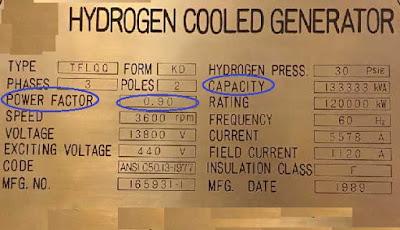The rating of AC Machines such as Transformer, Alternators etc. are determined by the heating and hence losses in them. These losses are made up of Ohmic (I2R loss ) and Core Loss and a small amount of friction & windage loss. The ohmic loss depends upon the current and the core loss depends upon the voltage, therefore the losses in an electrical AC machine are unaffected by the power factor of the load. In view of this, the rating of AC machinery is determined by volt-ampere of the load not by the load power alone. Therefore the Alternators or Synchronous Generators are rated in kVA or MVA.
You may like to read Losses in Electrical Machine – Core Loss and Eddy Current Loss
It shall be noted here that the size of boiler or the fuel requirement is solely determined by the output power and not on the volt-ampere. For example, for 700 MW load at 0.85 power factor, the rating of Alternator or Synchronous Generator will be 823 MVA (700/0.85 = 823) while the fuel requirement and size of boiler will be decided by 700 MW. To be more accurate, as the efficiency of Carnot Cycle is around 33%, if we assume Carnot Steam Cycle for simplicity then the fuel requirement or size of boiler to generate a power of 700 MW will be around 3 times the output power i.e. 3×700 = 2100 MW. It is very surprising that only 1/3 of the total input power (2100 MW) is converted into electrical power output but it’s true. Remaining power is lost in NDCT (Natural Draft Cooling Tower and losses during the whole steam cycle).
It shall be mind here that for stating the rating of an Alternator, we must include the steady state operating power factor along with the MVA / kVA rating. The need for mentioning power factor arises because the Alternator designed to operate at 0.85 power factor will require more filed current if operated at 0.8 power factor to maintain constant terminal voltage. More filed current at lower power factor means more losses in the field winding which in not desirable. If on the name plate of an Alternator, it is not mentioned that whether the power factor is lagging or leading then it shall be assumed to be lagging because for constant terminal voltage, lagging power factor will require more field current than the leading power factor. Thus lagging power factor puts a limit on exciter output and current in the field coil.
Under rated power and voltage conditions, reactive power flow handled by an Alternator is limited by the armature heating for operating power factor near the rated value. If the operating power factor is away from the rated value, then the reactive power flow is limited by both the armature and filed heating. Figure below shows a typical Name Plate of a Generator of 120 MW. Mind the kVA rating and Power factor.
You may like to read Why Hydrogen used for the Rotor Cooling of Generator
Normally Generator Capability Curve is provided by the manufacture from which we can get the operating point and the various limits like armature heating, filed heating and End part heating. We will be discussing the Generator Capability Curve in next post.
